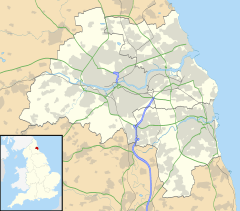All Saints' Church, Monkwearmouth facts for kids
Quick facts for kids All Saints' Church |
|
|---|---|
| 54°54′54″N 1°22′48″W / 54.915°N 1.380°W | |
| OS grid reference | NZ398580 |
| Location | City of Sunderland |
| Country | England |
| Denomination | Anglican |
| Website | www.monkwearmouthcofe.com |
| History | |
| Status | Parish church |
| Founded | 3 September 1844 |
| Consecrated | 23 October 1849 |
| Architecture | |
| Functional status | Active |
| Architect(s) | J. Dobson Esq |
| Architectural type | Early English Style |
| Completed | 13 May 1849 |
| Construction cost | £2,200 |
| Administration | |
| Parish | Monkwearmouth |
| Diocese | Durham |
| Province | York |
All Saints' Church is a historic church located in Monkwearmouth, a part of Sunderland, England. It is an Anglican church, meaning it belongs to the Church of England. This church has a special history, including its connection to a religious movement called Pentecostalism.
Contents
All Saints' Church: A Historic Place
All Saints' Church was built because the main church in Monkwearmouth, St Peter's, became too small. More people were living in the area, and there wasn't enough space for everyone. So, a new church was needed.
Building the Church
The idea for a new church parish, or area, for All Saints' was started in 1844. The construction of the church itself was finished on May 13, 1849. It was officially opened and blessed on October 23, 1849. The architect who designed the church was J. Dobson Esq. The building cost about £2,200 at that time, which was a lot of money!
A Special Connection to History
All Saints' Church is known for something very important in religious history. One of its early leaders was a vicar named Alexander Boddy. Because of his work there, All Saints' Church became known as the starting point for modern British Pentecostalism. This is a type of Christian faith that focuses on a close, personal experience with God.
All Saints' Today
Today, All Saints' Church is still an active church. It is now part of the larger Parish of Monkwearmouth again. It continues to serve its community in Sunderland.
External Links
- Parish homepage


